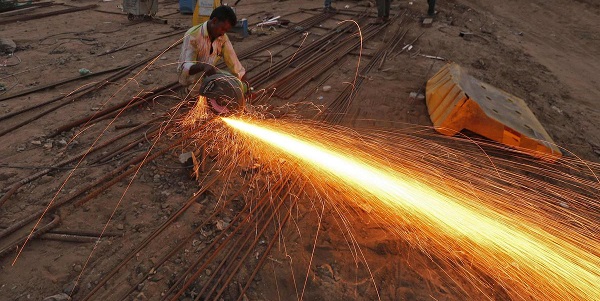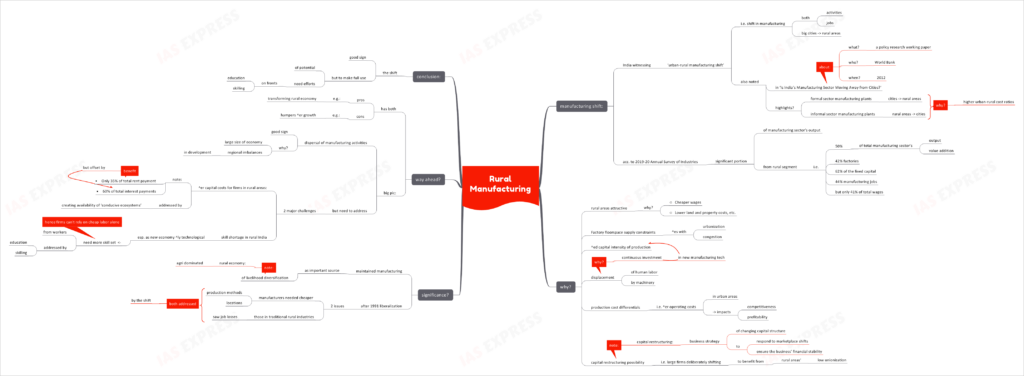Rural Manufacturing- Trends, Reasons & Significance

The rural economy has always played a deciding role in supporting the overall demand and hence, the health of Indian economy. Over the year, India’s rural areas have been acquiring another significant place in the economy- as preferred destinations of manufacturing firms.

Is India’s manufacturing sector moving away from the cities?
- The ‘urban-rural manufacturing shift’ i.e. a notable shift in manufacturing activities and manufacturing-related job opportunities from India’s big cities to the small towns and rural areas, is a trend that is becoming increasingly conspicuous.
- The World Bank published a policy research working paper in 2012, ‘Is India’s Manufacturing Sector Moving Away from Cities?’ that took note of this trend.
- The paper noted that formal sector manufacturing plants were moving away from cities and into rural India.
- At the same time, the informal sector manufacturers were shifting from rural locations into urban areas.
- This implies that the shift was being driven by higher urban-rural cost ratios.
- The 2019-20 Annual Survey of Industries shows that a significant portion of the manufacturing sector’s output comes from the rural segment.
- 50% of the total manufacturing sector output and value addition is from the rural factories.
- 42% of the factories are now in rural areas.
- 62% of the fixed capital is in the rural areas.
- 44% of manufacturing sector employment is in the rural areas.
- However, rural areas account for only 41% of the total wages of the manufacturing sector.
Why are manufacturers favouring rural India?
- Rural areas are attracting manufacturing firms because of:
- Cheaper wages
- Lower land and property costs, etc.
- Factory floorspace supply constraints, which increases with increased urbanization and congestion
- Increased capital intensity of production
- Displacement of human labour by machinery due to continuous investments in new manufacturing technologies
- Production cost differentials- i.e. higher operating costs in urban areas impact the manufacturer’s competitiveness and profitability.
- Capital restructuring possibility-
- Capital restructuring is a kind of business strategy, involving changing the capital structure of the firm, to respond to marketplace shifts and to ensure the business’ financial stability.
- In accordance with this perspective, the larger firms are deliberately moving to rural India to take advantage of the less unionized labour-force.
What is the significance?
- This urban-to-rural shift has maintained manufacturing as an important source of livelihood diversification in the agriculture-dominated rural areas.
- In the aftermath of the 1991 trade liberalization, Indian manufacturers were forced to look for cheaper means and locations of production, to survive the increased competition presented by imports. At the same time, traditional rural industries faced employment losses.
- This urban-rural shift of manufacturing helped make up for both these fallouts.
What is the way ahead?
- This shift to rural India has its set of advantages and constraints. For instance, it could help transform rural economy, but could also hamper higher growth.
- Big picture view: the dispersal of manufacturing activities is a good sign, given the Indian economy’s size and the regional imbalance in development.
- However, there are 2 major challenges that need addressing:
- Higher capital costs for firms in rural areas:
- This can be seen from share taken up by these firms’ rent and interest payments.
- Only 35% of total rent payment
- 60% of total interest payments
- This implies that the benefits gained from one aspect is being offset by the higher costs on other fronts.
- Skill shortage in rural India:
- Given the increasingly technological nature of the new economy, manufacturing firms require workers with more skill set than in the past.
- If the firms were to rely solely on cheap but low-skilled labour, they are bound to lose their cost advantage in the long run.
- Improving education and skilling in rural areas is key to realizing the full potential of this shift.
- Also, the global competition dictates that manufacturing firms need to look beyond just low cost productions. Their success also depends on the availability of ‘conducive ecosystems’ in the rural areas.
Conclusion:
The shift in manufacturing activities from urban to rural areas is a good sign in that it is diversifying and strengthening rural economy. However, efforts are required on the education and skilling fronts, to realize the full potential of this trend.
Practice Question for Mains:
Comment on the significance of ‘urban-rural manufacturing shift’. How can India leverage this trend? (250 words)
If you like this post, please share your feedback in the comments section below so that we will upload more posts like this.

